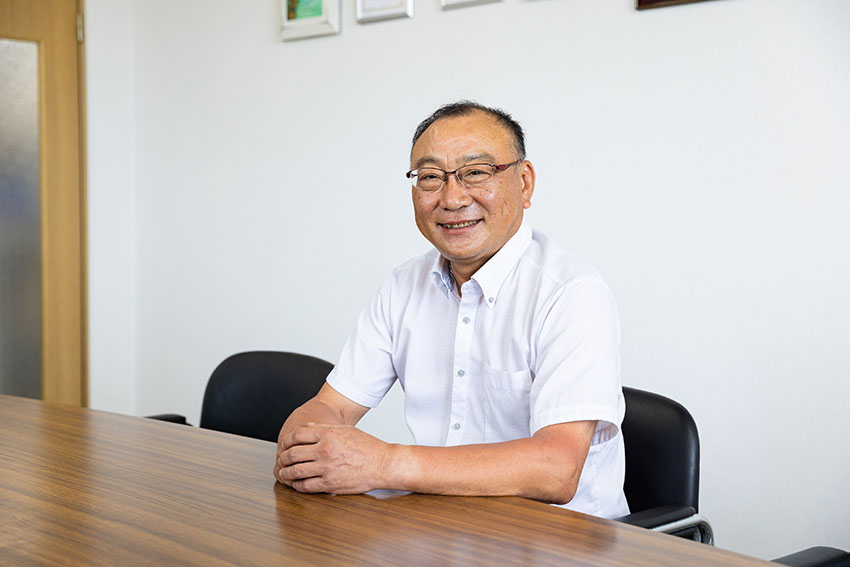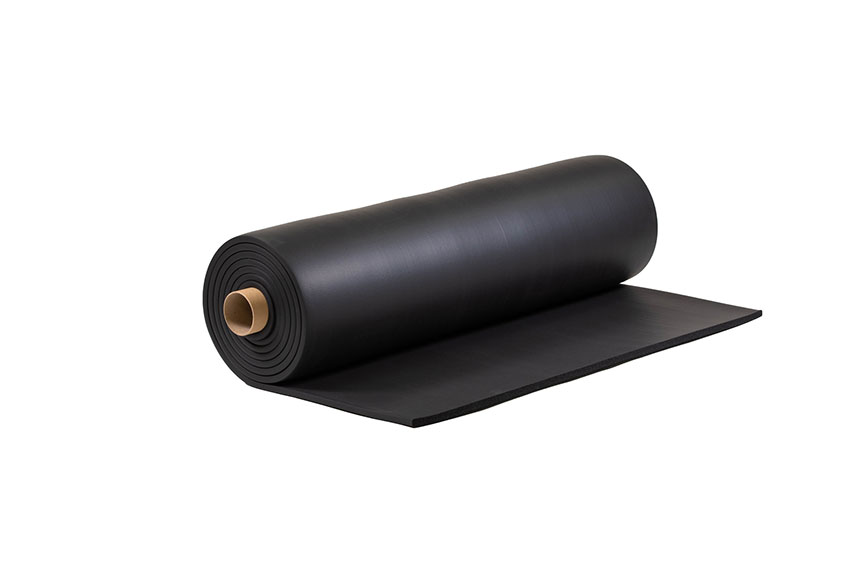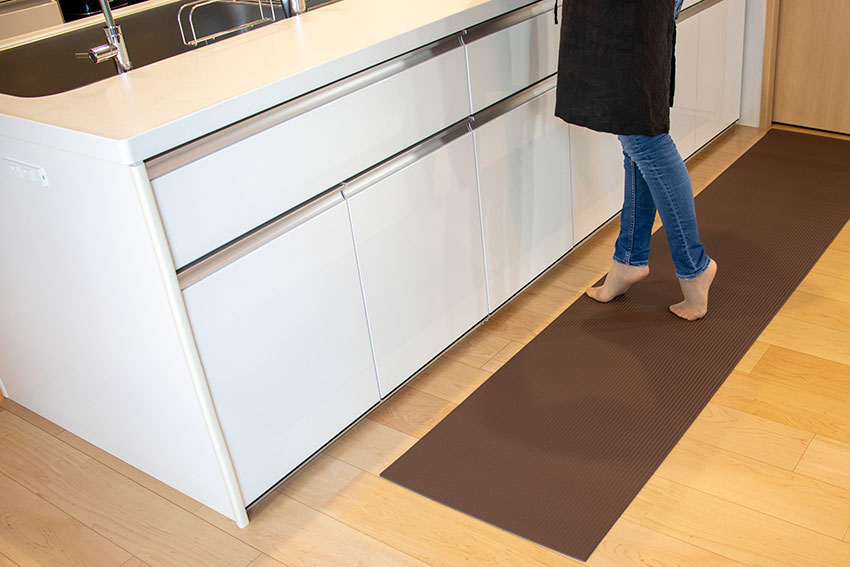Starting with the United States, Okayasu Rubber is bringing its unique manufacturing and proposal expertise of rubber components from Shiga to the world.

What is your take on monozukuri?
The simple answer in a nutshell, is a cultural difference. Japanese culture is different from those overseas. For example, we produce parts or components for automobiles, say 1,000,000 pieces, and if even one piece is the defective, it will cause a big problem.
In the case of Japan, quality control is a big issue and because of that we implement Kaizen (continuous improvement) to reach 100% performance. This is the difference.
We were talking about these questions yesterday and myself and the vice president have the same idea. Our monozukuri may be different from what you think it is. It's not what you make, it's how you make it. It's an attitude about how to make things that truly address both the current and future needs of our customers. To create something reasonable, and of real benefit to customers.
Our concept of monozukuri is not just making something according to a drawing or design given by customers. We need to also investigate and think, together with the customer, whether the design itself is optimal.
Sometimes we will propose changes the design, because we really want to work for their sake. For example, sometimes we suggest using less expensive materials or better materials, or we propose other processes that will enhance the power supply.This design or preparatory stage, before actually making things, is monozukuri for us.
We often visit and work closely with our customers to really establish and understand what the part is for, and then we make a proposal as to how to modify the part. For example, to make it a slightly different shape, or even to change the material they’re using. If they want to get cheaper parts, we can offer different materials or look into how we can make this particular part cheaper without compromising quality. That is our monozukuri.
One of the emergent problems for small to medium sized companies like yourselves has been the aging of Japan's population and the departure of skilled workers due to their age, and the challenge of preserving that culture. Can you tell us a little bit about what the impact of Japan's aging population has been for your business? What are some of the challenges, but also the opportunities that you see, given Japan’s unique demographic situations?
We are making our best efforts to foster young, skilled workers as much as possible in terms of the succession of techniques. We ask retired workers who are highly skilled craftsman to come and help support the young technicians.
Once a week, the younger workers can present the issues they face, and together with the skilled workers they can discuss how to solve them. It's not just a discussion around a table, it happens at the actual gemba – the workplace.
One of the impacts of the decreasing population has been people looking overseas, whether it be in Southeast Asia or the United States.
I mentioned that our monozukuri is not actually just making things, but about how to best manufacture something. Therefore, even if people are getting older and the labor force becomes smaller, we think we can cope with it because of our attitude to production. We can borrow the wisdom of older people who are no longer in the labor force now to maintain our culture.
In that sense, the ageing society is not really affecting us, but when it comes to the labor force itself, in overseas markets they mass produce things in large batches, but here in Japan we produce in small and medium-sized lots.
We can capitalize on our strengths in that sense when production is increased, and you might say that with a smaller labor force, it's harder to actually produce things, but we can take advantage of robots or machines, or we will enhance our automation to compensate.
I mentioned about the craftsman’s skill. All the craftsmen used to do monozukuri. It's not just hand skills, but all the - shokunin we call them shokunin - thinkking about how to make the best products or a really reasonable way to create the product. Thinking about how to make the best things should be done by many people, but those kinds of skills, or the manufacturing, can be done by machines or robots.

Tough long
I'd like to ask specifically about your Tough Long Sheet Series, which we understand are coated on both sides, and are created with a unique manufacturing method using extrusion and molding technology to achieve a very thin sheet, in many cases of just one millimeter. Can you tell us about some of the unique applications of the Tough Long Series?
This is something that I invented. Developing the idea alone took three years, and then of course you needed to design the machines from scratch. That took two years, so a total of five years.
Of course, this was something completely new so we didn't know whether it would sell or not, but I wanted to sell, and we made efforts, so it is gradually selling in higher numbers. In any case, our sales people did not sell this sheet so I made the suggestion, “Why don't we create a kitchen mat?”, so we came up with this wide, colorful rubber mat. It's easy to wipe, even if you spill sauce and things like that on it.
However, our distribution channels were all B2B, so there were no B2C channels for us. We therefore started in ecommerce. Direct sales on the internet. Then we started selling, for example, on Amazon, although we also had people, including my son, making efforts to create our online shop.
Conventional sponge sheets were on the market but could only sized one or two meters squared, without an outer skin. We asked for the opinion of our customers, and they all said, “Oh, we want a skin because it's water repellent. If it has a skin, it's easier to tape or glue its surfaces. Therefore, we really want the skin.” They also said, “With the two-meter size only, we cannot make a more than 2-meter product”.
Due to this feedback, we started thinking about how to produce a similar but more practical sponge sheet, eventually developing the Tough Long Series. It's an example of our monozukuri. It's similar to conventional products but with a totally different production method, one that doesn’t incur a large cost. The reason why we named it Fukuraku was because my wife said it's easy to wipe. Fuku means ‘wipe’ and raku means ‘easy’.
Generally, SME’s in Japan are not good at PR. For that reason, awareness among people is low so we needed to do something to draw more attention to ourselves, and raise awareness. The rubber parts industry is very conservative and afraid of changes. Therefore we needed to do something completely different, and this product came up.
We participate in various types of exhibitions where we also show the Fukuraku kitchen mat, and those people are our customers. Business customers come and see that it is good, and they always visit our website to find out about our other products. This enhances our credibility, so I truly feel there is a synergistic effect.

Fukuraku mat
Can you tell us more about what the impact of the automotive sector's transformation has been on your business, and how you're meeting some of these new challenges?
This transformation of the industry presents a great opportunity for us. We are not a big company, so from the beginning we had nothing to lose and a lot to gain.
Due to this transformation of the industry, there were many new companies looking for suppliers of rubber parts. Therefore, non-traditional customers are now making inquiries to us, so in terms of sales channels, this brings opportunities for us.
When it comes to our monozukuri, as you know, rubber is vulcanized using sulfur. However, sulfur is not very good for electrical components, so customers want rubber that isn’t made with sulfur. That's where we come in. With our attitude of monozukuri, we are always coming up with new ways to meet our customers’ demands.
The reason why we can do this is because we’ve had a long relationship with Panasonic. More than 50 years. Therefore, we are very good at producing rubber parts for electrical appliances.
We’ve been told that we’re a “good enough” supplier, which is a compliment, and it means we're well skilled but not too big, so we can collaborate with other companies.
Big companies have their own way of doing things. If they consider a task or request to be too small, they will not bother to develop the necessary technology, or try to satisfy that demand from their customers.
However, with our size, we have the technologies, skills and the spirit of monozukuri starting from the concept of working together with customers on the design and processing. Therefore, even the non-traditional automobile manufacturers can collaborate with us and start assembling parts.
You are established in San Antonio, TX and Malaysia. What are the key steps, moving forward, in terms of your international expansion? Are you more focused on finding collaborative partners? Are you trying to find new clients looking for suppliers? Are you worried more about branding, getting your name out there in the new markets? What's next for your international development?
Well, this is not about overseas development, but the next step we take is building a second factory here at our headquarters. This will support our Tier 1 Japanese clients.
For Japanese companies based in Southeast Asia, we can provide items from Malaysia. However, now that these Japanese companies are building their factories in the United States and Mexico, we cannot help but go there as well. We first need to have a warehouse and salespeople there. Therefore, according to our plan we’d like to build a factory there in three years.
We’d like to one day see America as our foothold for the America’s, and then maybe in six or nine years, we’ll also supply the Brazilian market. Maybe we will keep growing our American factory. We don't think we’ll put a factory in Brazil or Mexico because I heard it's difficult to keep things safe there, but maybe we’ll open a sales office in Brazil or Mexico, and then we’ll grow our Texas factory bigger and bigger to act as a hub.
The Japanese market is shrinking so our headquarters can act as a mother factory and develop many techniques or formulas to be used at our other locations. Malaysia is our key manufacturing location to supply all of Asia.
I was in Malaysia from 1994 for eight years. On that occasion, I brought my family. In those days I was not very good at English, so I wanted my children to study it. My first son went to a UK-related international school, and my second son can also speak well because I brought my family to Malaysia.
One of the problems all Japanese companies are facing is that not many of their employees are globally oriented. They are not willing to go abroad, although my sons are pretty international. They are willing to go and work abroad but we do not find many employees like that.
Going overseas and working there involves a certain amount of risk, and in that sense, we needed to send someone from our family for the launch of the business.
Nowadays, because we have successfully launched a business in Malaysia, our employees are operating the business there and we do not have any family members there. My sons will go and look at potential new places to set up an office. In this time, it was San Antonio, TX.
If we come back on your last day before fully handing the company over to the next generation, what would you like to have achieved? What are your dreams for the company?
My second son is going to launch a business in the USA and we hope it will be a successful one. As a matter of fact, I'm the third generation, therefore I myself received the baton from the previous generation.
I want to be satisfied with the situation where the company becomes a better one than when I received the baton, and I can successfully hand my baton to the next generation, hoping that the company will be even better going forward. I want to be satisfied that I pursued my responsibility to hand over the baton to the next generation successfully.
My eldest son, who is the vice president, is also taking on this philosophy. Our unique company culture is "constantly changing". Under this philosophy, with the leadership of the vice president, we are making an organizational change from this October onwards. We’ve already started.
We will continue pursuing kaizen, or continuous improvement, which is part of our culture. The best thing is to improve the situation, and the next best thing is to worsen the situation. The worst case is to do nothing, therefore I think I will be satisfied seeing the company changing and improving.
It's really difficult in this kind of manufacturing company because our people don't go out and see other companies. They only know our company and they only know this situation, so they really don't want to change anything. I know it's difficult for a manufacturing company, but we never want to stop growing.
0 COMMENTS